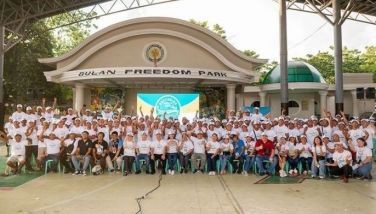Eid al Fitr – Muslim feast of breaking the fast

It was from Beth Ramirez of the UA&P that I first heard about the painting of San Cristobal, a floor to ceiling painting in Paete Church. That was some years ago. I have not followed its fate since and I blame myself because I should have. The last time I heard about it was from Maris Diokno of the National Historical Commission. I brought it to her attention and how important it was to allocate some funds to preserve it. The trouble was there were two groups claiming to be in charge of the San Cristobal painting and they could not get themselves to rise above their differences. I have tried to mediate but again I lost track and thought that they should have resolved it by now.
I will be going more often to Paete because like the salmon I will return to my origins before I die. I will find out just what happened to the project to preserve the painting. And what better time to push it than today (June 15), Ramadan – Eid al Fitr everyone.
The painting has two versions. One is dressed and has Malay features and the other had a more European Castillian looking San Cristobal. The one with Malay features, some claim is really Muslim. Why were two images of San Cristobal painted? The other one is believed to have been done first to portray a version of San Cristobal as Spanish Christian. That is all I know for the moment but there is a profound historical truth behind this dilemma that we should not brush aside.
It is the fact that Filipinos were Muslims before they were Christians. It is a truth often passed over but one into which we should look at more closely. From history books, we are indeed told that the Muslims were here before Christians and they were grouped into principalities with a ruler on top who governed. It was federalist because there was no central government. We had datus as rulers of sovereign states. It is time that lovers of art and especially Paetenos look into what was happening to the priceless treasures of this church. I remember on my vacations there as a child it was time to wake up when the church bells rang.
Beth sent me an article by Butch Dalisay to appreciate our loss when the San Cristobal was damaged in July 2012 —
As one enters the church, two paintings of San Cristobal are found on the wall to the left. It is a large figure that its enormity seems to tighten in the painting. The large figure of the saint emerging from the sea, holding on to a coconut tree and riding on his right shoulder, the child Jesus is not the same in measure as the large figure.
The first painting can be said to be the composition of a figure, a giant dressed in Filipino even though there are slight foreign features. Through painting shadows on the body one can notice the heavy strokes used and both light and darkness are separated in the form of the arms and foot. This picture is painted on a panel, those attached to sliced wood. Colors are dark and each shape has a stroke of color.
There is a legend saying there was an ugly creature with extraordinary strength that lived in Canaan during the early years of Christianity.
Legendary rulers can be found in the oral tradition in Philippine Mythology, which having an uncertain historical/archeological evidence of their reign.
Paete was probably under Gat Pangil, a chieftain in the area now known as Laguna Province. He is mentioned in the origin legends of Bay, Laguna, Pangil, Laguna, Pakil, Laguna and Mauban, Quezon, all of which are thought to have once been under his domain.
So those who want to adopt a federal system of government are really returning to our pre-Christian history.
Let us celebrate Ramadan by looking back at that history and know our origins. The types of sovereign state leaders in Philippine archipelago have varied throughout the country’s history, from heads of ancient chiefdoms, kingdoms and sultanates in the pre-colonial period, to the leaders of Spanish, American and Japanese colonial governments, until the directly elected president of the modern sovereign state of the Philippines.
Before the nation of the Philippines was formed with a central government the area of the pre-colonial times were sets of divided nations ruled by kings, chieftains, datus, lakans, rajahs and sultans in Southeast Asia. It was when the Spaniards arrived that they named the collections of areas they conquered in Southeast Asia as “Las Islas Filipinas” or The Islands of the Philippines.
Rulers during the Spanish colonization
During the Spanish colonization, Remaining monarchs reign until their kingdoms were absorbed to the new colonial nation of the Philippines through Spanish conquest. Many of these territories were absorbed much later. Among them were Rajah Colambu – king of Limasawa in 1521, brother of Rajah Siagu of Butuan. He befriended Portuguese explorer Ferdinand Magellan and guided him to Cebu on April 7, 1521.
Rajah Humabon – king of Cebu who became an ally of Ferdinand Magellan and the Spaniards, rival of Datu Lapu-Lapu. In 1521, he and his wife were baptized as Christians and given Christian names Carlos and Juana after the Spanish royalty, King Carlos and Queen Juana. Sultan Kudarat – Sultan of Maguindanao. Lakan Dula or Lakandula – king of Tondo, one of the last princes of Manila.
And of course, Datu Lapu-Lapu – king of Mactan Island who defeated the Spaniards on April 27, 1521 and became our first national hero.
- Latest
- Trending























